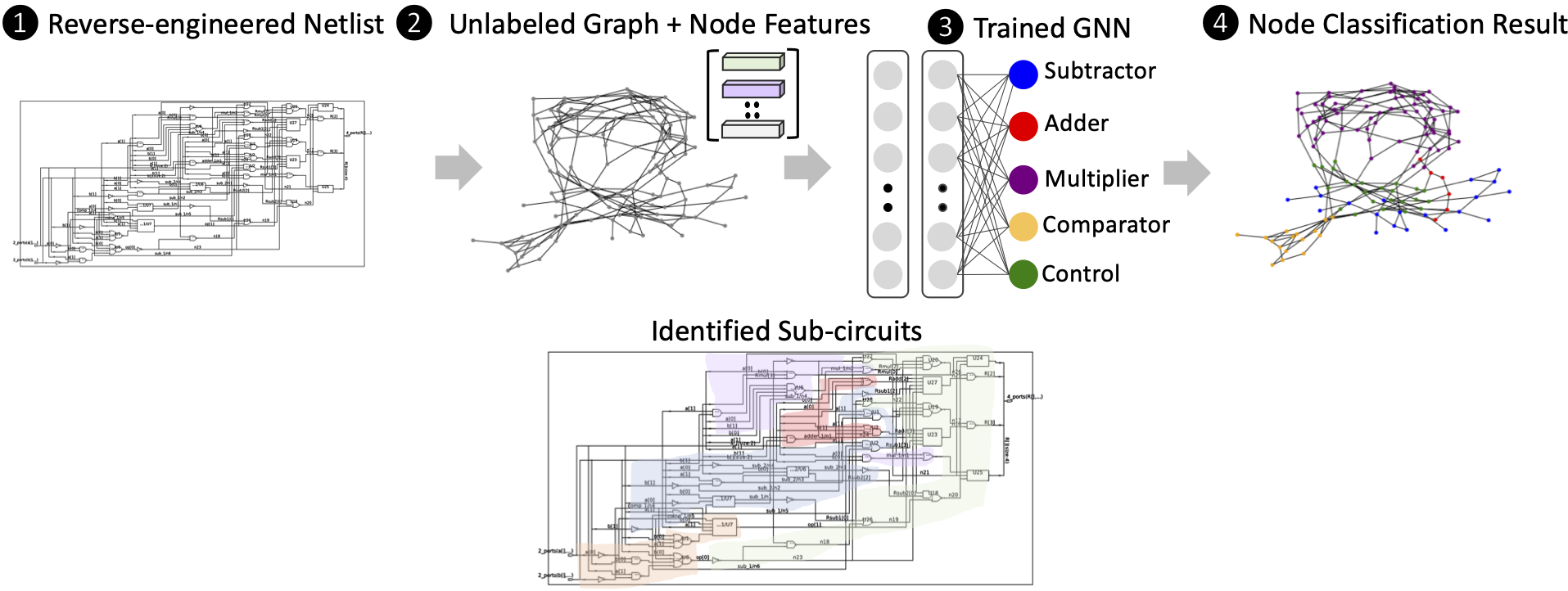Lilas Alrahis, Abhrajit Sengupta, Johann Knechtel, Satwik Patnaik, Hani Saleh, Baker Mohammad, Mahmoud Al-Qutayri and Ozgur Sinanoglu
Contact Lilas Alrahis (lma387@nyu.edu)
GNN-RE is a generic, graph neural network (GNN)-based platform for functional reverse engineering of circuits. GNN-RE (i) represents and analyzes flattened/ unstructured gate-level netlists, (ii) automatically identifies the boundaries between the modules or sub-circuits implemented in such netlists, and (iii) classifies the sub-circuits based on their functionalities.
This repo contains the source code of the netlist-to-graph transformation from our paper (TCAD '21, see the Citation Section). The scripts released here parse the designs in Netlist format. Please contact Lilas Alrahis (lma387@nyu.edu) if you wish to expand Verilog netlists parsing to handle different tech libs.
-
python >= 3.6.8
-
tensorflow >=1.12.0 / pytorch >= 1.1.0
-
cython >=0.29.2
-
numpy >= 1.14.3
-
scipy >= 1.1.0
-
scikit-learn >= 0.19.1
-
pyyaml >= 3.12
-
g++ >= 5.4.0
-
openmp >= 4.0
-
GraphSAINT - Graph sampling-based training for node classification.
-
More info regarding conda env setup/creation is given below.
The ./Netlist_to_graph/Circuits_datasets/ directory contains the Interconnected-Modules dataset used in (TCAD'21). The dataset contains 37 designs. Five different sub-circuit classes exist in the dataset, i.e., adders, multipliers, control logic, subtractors, and comparators. All the designs are synthesized using Synopsys Design Compiler with Global Foundries 65nm LPe. We also release the original Interconnected-Modules RTL dataset in ./RTL_Dataset.zip so that the users can synthesize the designs using different standard cell libs if needed.
When creating a dataset, the files used for training, validation or testing must be identified. To split files into Test/Train/validate, the files must be named accordingly. A locked file must be named as follows: [Test|Train|Validate]_*.v
Scripts
The following scripts are required for the conversion:
./Netlist_to_graph/Parsers/TheCircuit.pm: a Perl module we create to ease circuit's parsing. This module is required by our parser ./Netlist_to_graph/Parsers/netlist_to_graph_re.pl
./Netlist_to_graph/Parsers/netlist_to_graph_re.pl: a Perl script that reads all of the designs (Synthesized Gate-level Netlists) in a given dataset and converts the dataset into a single graph. It assigns unique numerical IDs (0 to N-1) to the nodes (gates). N represents the total number of nodes (gates) in the dataset. The list of nodes in the training set will be dumped in tr.txt. The list of nodes in the testing set will be dumped in te.txt. The list of nodes in the validation set will be dumped in va.txt. The extracted features will be dumped in feat.txt. The existence of an edge i between two vertices u and v is represented by the entry of ith line in row.txt (representing u's ID) and the entry of the ith line in col.txt (representing v's ID). The row_tr.txt and col_tr.txt are created to identify the edges exclusive to the training set.
./Netlist_to_graph/Parsers/graph_parser.py: a Python script that processes the files created by the Perl parser and generates the files required by GraphSAINT. It will mainly create the following files:
dataset_log.txt: log file with detailed information about the dataset.
adj_full.npz: a sparse matrix in CSR format, stored as a scipy.sparse.csr_matrix. The shape is N by N.
adj_train.npz: a sparse matrix in CSR format, stored as a scipy.sparse.csr_matrix. The shape is also N by N. However, non-zeros in the matrix only correspond to edges connecting two training nodes.
role.json: a dictionary of three keys. Key 'tr' corresponds to the list of all training node indices. Key va corresponds to the list of all validation node indices. Key te corresponds to the list of all test node indices.
class_map.json: a dictionary of length N. Each key is a node index, and each value is a length C binary list. C represents the number of classes which is 5 in our case, i.e., label 0 for adders, label 1 for multipliers, label 2 for control nodes, label 3 for subtractor nodes, and label 4 for comparator nodes.
feats.npy: a numpy array of shape N by F. F is the length of the feature vector. For the case of our dataset, F=34.
Running the Conversion
- Create and activate conda environment with the required dependencies.
$ conda create --name myenv python=3.6.8 tensorflow=1.12.0 $ conda activate myenv $ conda install -c anaconda numpy=1.14.3 $ conda install -c anaconda scipy=1.1.0 $ conda install -c anaconda scikit-learn=0.19.1 $ conda install -c anaconda pyyaml=3.12 $ conda install -c conda-forge openmp=4.0 $ conda install -c anaconda cython=0.29.2
- Modify line 6 in
./Netlist_to_graph/Parsers/netlist_to_graph_re.pland place the full path totheCircuit.pm. - Perform the conversion:
$ mkdir -p ./Netlist_to_graph/Graphs_datasets/Interconnected-Modules/ $ cd ./Netlist_to_graph/Graphs_datasets/Interconnected-Modules/ $ cp ../../Parsers/graph_parser.py . $ perl ../../Parsers/netlist_to_graph_re.pl -i ../../Circuits_datasets/Interconnected-Modules > log.txt $ python graph_parser.py $ cd ../../../
GNN-RE requires GraphSAINT to perform node classification (ICLR'20). We have used the TensorFlow implementation of GraphSAINT in all of the experiments reported in (TCAD'21).
To install GraphSAINT:
$ git clone https://github.com/GraphSAINT/GraphSAINT.git
$ cd GraphSAINTCompilation (done only once)
$ python graphsaint/setup.py build_ext --inplaceLaunch Node Classification: First activate the created conda env and then:
$ python -m graphsaint.tensorflow_version.train --data_prefix ../Netlist_to_graph/Graphs_datasets/Interconnected-Modules --train_config ../TCAD.yml --gpu -1 > log_training.txtTCAD.yml contains the hyperparameters used in (TCAD'21).
If you find the code useful, please cite our paper:
- TCAD 2021:
@ARTICLE{9530566,
author={Alrahis, Lilas and Sengupta, Abhrajit and Knechtel, Johann and Patnaik, Satwik and Saleh, Hani and Mohammad, Baker and Al-Qutayri, Mahmoud and Sinanoglu, Ozgur},
journal={IEEE Transactions on Computer-Aided Design of Integrated Circuits and Systems},
title={{GNN-RE}: Graph Neural Networks for Reverse Engineering of Gate-Level Netlists},
year={2021},
pages={1-1},
doi={10.1109/TCAD.2021.3110807}}
We owe many thanks to Hanqing Zeng for making his GraphSAINT code available.
